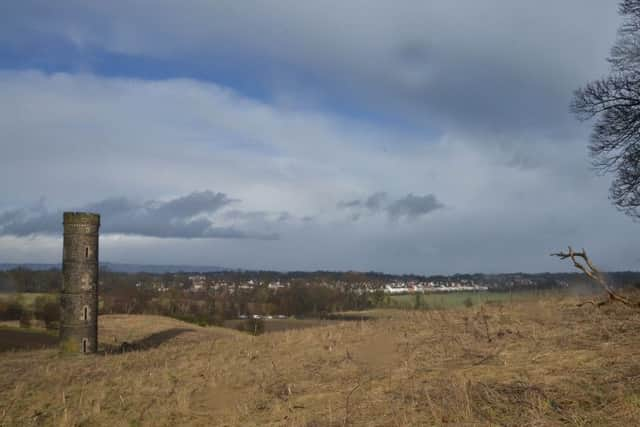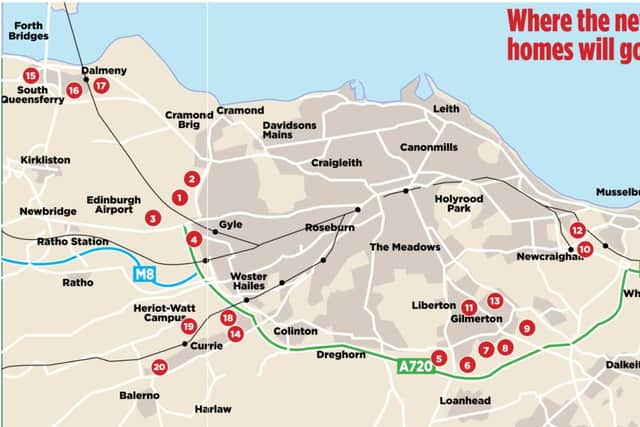Council chief says Local Development Plan ‘mince’


Campaigners from across the city hoping to stop the development of thousands of homes in their areas queued up to plead with councillors for an eleventh hour reprieve, but left empty handed.
Thousands of homes are now set to be built across the west and east of the Capital, with residents warning that acres of precious greenbelt will be lost, roads gridlocked, and schools and medical facilities swamped with an influx of new residents.
Advertisement
Hide AdAdvertisement
Hide AdThe most dramatic outbursts of the day came from the SNP councillors on the committee, with deputy council leader Sandy Howat laying bare his displeasure with the LDP he voted for.


Referring to the assessment of contentious areas by council planners, Cllr Howat said: “If the reporter looks at it, they’ll see that a lot of the points in there about accessibility, transport infrastructure, is indeed mince in the report.”
And economic development leader Frank Ross blasted the plan as a “fantasy”, criticising Scottish Government housebuilding targets before voting against his party’s own policy.
____________________
Where the new homes will go


1. Maybury: 1700-2000 homes
2. Cammo: 500-700 homes
3. International Business Gateway: 300-400 homes
4. South Gyle: 450-700 homes
5. Broomhills: 425-595 homes
6. Burdiehouse: 250-350 homes
7. Gilmerton Dykes Road: 50-70 homes
8. Gilmerton Station Road: 350-490 homes
9. The Drum: 125-175 homes
10. Newcraighall: 425-595 homes
11. Ellen’s Glen Road: 220-260 homes
12. Brunstane: 950-1330 homes
13. Moredunvale Road: 188 homes
14. Curriemuirend: 150-180 homes
15. Builyeon Road, Queensferry: 700-800 homes
16. South Scotstoun, Queensferry: 365-510 homes
17. Dalmeny: 12-18 homes
18. Riccarton Mains Road: 25-35 homes
19. Curriehill Road: 50-70 homes
20. Newmills Road: 175-245 homes
____________________
“We as councillors should not allow this process to override our responsibility to those citizens who elected us to represent them.”
Campaigners warned that the city will spread outwards, paving over the gaps between Edinburgh and Musselburgh, Currie and Balerno, creating a continuous urban sprawl from west to east.
One campaign group fighting development at Brunstane warned councillors that its members “have the will and the means” to push for a judicial review of the LDP decision, and have already sought legal advice.
The threat prompted enough concern that convener Ian Perry called a 15 minute recess to consult the committee’s legal advisers.
Martin Kelly, a lawyer and spokesman for the Brunstane group, told the Evening News: “The council’s decision to approve the LDP as it stands, despite several powerful objections, beggars belief.
Advertisement
Hide AdAdvertisement
Hide Ad“The Planning Committee’s reason for not making any changes to the LDP – that doing so would cause further delay – makes a mockery of the consultation process. What’s the point of asking the people of Edinburgh for their views on the draft LDP if the council had already closed its mind to making any changes?
“The LDP now goes to the Scottish Government for ‘examination’ and we hope that the reporter will see the sense in our objections and recognise the force of our legal argument. If not, we stand ready to have the LDP overturned by the Court of Session.”
Abandoning an earlier plan to amend the LDP, removing contentious sites such as Brunstane, Newmills and Curriemuirend Park, councillors instead attached recommendations to the Scottish Government planning reporter, who will now scrutinise the blueprint, saying the objections to several areas have “merit”.
Councillors also made a recommendation in favour of the Garden District, a strip of land between the M8 and A8 near Gogar, which has not been included in the LDP but which could absorb a large chunk of the city’s housing growth, relieving pressure elsewhere. However, critics dismissed the move as an empty gesture.
In almost two hours of deputations, the plan was slated by residents’ groups and ward councillors, some of whom refused to endorse their own party’s LDP policy even when pressed by opposition members of the committee.
Craigmillar community councillor Paul Nolan said plans for Brunstane would “destroy an environmental jewel of Edinburgh”. And Sally Chalmers, spokeswoman for the Cammo Residents’ Association, complained to councillors that the entire process was “fundamentally flawed”, with residents discouraged from giving their views by a mountain of paperwork and impossible-to-understand jargon.
Conservative councillors attempted to have the LDP reopened, striking out contentious areas and consulting the public on alternatives including the Garden District. However, their amendment was defeated after a stark warning from convener Ian Perry that any changes could further delay the plan until February 2017 – almost two years away.
Tory councillor Joanna Mowat called the administration’s handling of the LDP a “dog’s dinner” and “undemocratic” and opposition leader Cameron Rose said the city was “outsourcing” its democratic planning powers to the Scottish Government, adding: “That is a total cop-out.”
Advertisement
Hide AdAdvertisement
Hide AdAhead of a final vote, Cllr Perry warned that the city was already subject to “planning by appeal” because of its delay in getting a plan approved – with developers who have applications to build on the greenbelt rejected by city planners able to appeal to the Scottish
Government, which operates with a presumption in favour of housing.
One 110-home site, at the Edmonstone Estate, has already been approved on appeal by Communities Secretary Alex Neil after being rejected by the council.
Cllr Perry said: “If we don’t adopt this today then we can’t defend against applications on the greenbelt. We all know there are applications waiting out there to come in. We are going to have difficulty resisting them.”
Backers of the Garden District welcomed the broad support for the site as an
alternative to controversial greenbelt developments, despite the failure to include it in the LDP.
A spokesman for Murray Estates, which owns the site, said: “We’re very encouraged by the committee decision, and by all of the positive
comments.”
And figures from the house building industry welcomed an end to over a year of planning gridlock. Nicola Barclay, Director of Planning at trade body Homes for Scotland, said: “Whilst we still have major concerns with the draft plan, after such lengthy delay we are relieved that further setback has been avoided.”
What is the LDP – and why does it matter?
Advertisement
Hide AdAdvertisement
Hide AdScottish planning rules require councils to do two things: maintain a sufficient supply of land for housing, and pass a Local Development Plan (LDP) that sets out where those homes can be built. Edinburgh hasn’t had a happy experience of either.
Because the Capital is one of the few areas experiencing rapid growth, housing demands are huge: the Scottish Government says the city has to build 32,000 new homes by 2024. Some commentators say that figure is excessive and more than builders can produce. Others point to rising house prices and long waiting lists as evidence of the need.
Deciding where those homes go is just as contentious. A first attempt at passing an LDP stalled last year because SNP and Labour councillors couldn’t agree on sites, something that again threatens to split the coalition.
Another problem lies just over the horizon: how to pay for schools and roads to go along with the new housing. The bill is at least £200m, and could be as much as £800m if the city needs to borrow the money.